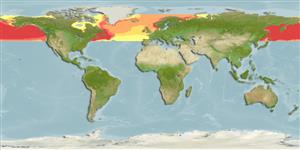Common names from other countries
分類 / Names
共通名の | 類義語 | Catalog of Fishes(部類, 種) | ITIS | CoL | WoRMS | Cloffa
>
Osmeriformes (Freshwater smelts) >
Osmeridae (Smelts)
Etymology: Osmerus: Greek, osme = odorous; similar to freshly cut cucumbers (Ref. 45335); mordax: mordax meaning biting (Ref. 10294).
More on author: Mitchill.
Environment: milieu / climate zone / depth range / distribution range
生態学
海; 新鮮な水; 汽水性の; 昇流魚 (Ref. 51243); 深さの範囲 0 - 425 m (Ref. 58426), usually ? - 150 m (Ref. 96339). Temperate; 6°C - 18°C (Ref. 1998); 73°N - 41°N, 167°W - 53°W (Ref. 86798)
North Atlantic: Atlantic drainages from Lake Melville in Newfoundland and Labrador, Canada to Delaware River in Pennsylvania, USA and west through Great lakes. Arctic and Pacific drainages from Bathurst Inlet, Northwest Territories to Vancouver Island in British Columbia, Canada. Also Pacific drainages of Asia.
Length at first maturity / サイズ / 重さ / 年齢
Maturity: Lm 19.5 range ? - 19.8 cm
Max length : 35.6 cm TL オス/雌雄の選別がない; (Ref. 1998); 最大記録サイズ: 7 年 (Ref. 52222)
背面の脊椎 (合計) : 0; 背鰭 (合計) : 8; 肛門の骨: 0; 臀鰭: 12 - 16; 脊つい: 58 - 70. Body elongate, laterally compressed, greatest depth at anterior of dorsal fin origin. Head moderate; eye moderately large; snout elongate, pointed. Mouth large; lower jaw protruding, maxillary extending to middle of eye or beyond, well toothed on vomer, palatine, pterygoid, basibranchial, dentary, maxillary, and tongue. Teeth specially enlarged on tongue and front of vomer. Body color is pale green on back, with purple, blue, and pink iridescent reflections on the side when freshly caught.
Nerito-pelagic (Ref. 58426). Inhabits cool clear lakes, medium to large rivers, and coastal waters (Ref. 86798). A schooling species that occurs in midwater of lakes or inshore coastal waters (Ref. 1998); at temperatures ranging from 7.2-15.6°C. Coastal population are anadromous (Ref, 86798). Migrates up to 1,000 km upstream in rivers (Ref. 6793). Occurs possibly to 425 m (Ref. 2851). Feeds on invertebrates such as amphipods, ostracods, aquatic insect larvae and aquatic worms (Ref. 1998); food also include copepods, euphausiids, mysids and small fishes (silversides, mummichogs and herring) (Ref. 5951, 10294). Headed, gutted, sold fresh, frozen and precooked. Eaten sautéed and fried (Ref. 9988).
Spawning runs occur when temperature is between 8.9-18.3°C, may last for 3 weeks, peak for 1 week. Lengths of both sexes decrease as spawning progress. Two or more tuberculated males maintain position against a female in swift water, eggs released in clusters and presumably milt released simultaneously. Spawning usually takes place at night, spawners move downstream to the lake during daytime.
Mecklenburg, K.C., P.R. Møller and D. Steinke, 2011. Biodiversity oif the Arctic marine fishes: taxonomy and zoogeography. Marine Biodiversity 41(1):109-140. (Ref. 86838)
CITES (Ref. 128078)
Not Evaluated
Human uses
水産業: 商業; ゲームフィッシュ: はい
用具
特記事項
XMLをダウンロードして下さい
インターネットの情報源
Estimates based on models
Preferred temperature (Ref.
115969): 0.2 - 6.9, mean 2.7 (based on 724 cells).
Phylogenetic diversity index (Ref.
82804): PD
50 = 0.5625 [Uniqueness, from 0.5 = low to 2.0 = high].
Bayesian length-weight: a=0.00407 (0.00328 - 0.00506), b=3.15 (3.08 - 3.22), in cm Total Length, based on LWR estimates for this species (Ref.
93245).
栄養段階 (Ref.
69278): 3.0 ±0.0 se; based on diet studies.
回復力 (Ref.
120179): 手段, 1.4年~4.4年の倍増期間の最小個体群 (K=0.31; tm=2-6; tmax=6; Fec=8,500).
Fishing Vulnerability (Ref.
59153): Moderate vulnerability (38 of 100).
Climate Vulnerability (Ref.
125649): Low to moderate vulnerability (32 of 100).
